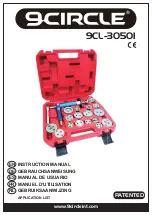
ENGLISH
29
5. Slowly feed the accessory into the workpiece
using the feed handle (e).
6. At the start of the cut, apply light pressure to
allow the accessory to perform the initial groove.
7. Continue applying sufficient pressure to achieve
a smooth progressive cut. Do not force.
8. The pressure exerted on the handle is too high if
the stand comes loose from the work surface.
9. Take extra care when the accessory is about to
break through the surface to prevent splintering.
10. Always turn off the motor, the magnet and the
power, in that particular order, when work is
finished and before unplugging.
Drilling with Annular Cutters
Annular cutters only cut material at the periphery of
the hole, rather than converting the entire hole to
shavings. As a result, the energy required to make a
hole is lower than for a twist drill.
When drilling with an annular cutter, it is not
necessary to drill a pilot hole.
WARNING:
Do not touch the cutter or
the parts close to the cutter immediately
after operation, as they may be
extremely hot and cause burns to the
skin.
Ensure nobody is in the work area
where the metal core is ejected.
Drilling Conditions
The ease with which material can be drilled depends
on several factors including tensile strength and
abrasion resistance. Whilst hardness and/or strength
is the usual criterion, wide variations in machineability
can exist among material showing similar physical
properties.
The drilling conditions are dependent on
requirements for tool life and surface finish. These
conditions are further restricted by the rigidity of the
tool and the workpiece, lubrication and machine
power available. The harder the material, the lower
the cutting speed.
Some materials of low hardness contain abrasive
substances leading to rapid cutting edge wear at
high speeds. Feed rates are governed by rigidity of
set-up, volume of material to be removed, surface
finish and available machine power.
MAINTENANCE
Your D
E
WALT power tool has been designed to
operate over a long period of time with a minimum
of maintenance. Continuous satisfactory operation
depends upon proper tool care and regular cleaning.
WARNING: To reduce the risk of
injury, turn unit off and disconnect
machine from power source before
installing and removing accessories,
before adjusting or changing
set- ups or when making repairs.
Be
sure the switch is in the OFF position.
An accidental start-up can cause injury.
Pop-off Brushes
After 80 hours, the motor will be automatically shut
off indicating that the carbon brushes are nearly
worn out and that the tool needs servicing. The
carbon brushes are not user-serviceable. Take the
tool to an authorised D
E
WALT repair agent.
Lubrication
IN HORIZONTAL APPLICATIONS
• Adjust the fluid flow as required using the flow
regulator (v) (fig. 4).
• Add more cutting fluid if the shavings become
blue.
VERTICAL AND OVERHEAD APPLICATIONS
Dip the cutter in cutting paste or apply an
appropriate spray.
LUBRICATING THE FEED TRAVEL (FIG. 9)
The feed travel should be lubricated periodically with
grease to ensure smooth operation.
• Raise the motor unit to the highest position
possible.
• Lubricate the dove-tail guide way (gg) at both
sides.
• Lubricate the gear rack (hh).
After repeated use, the gear rack may become
loose. If necessary, adjust the 5 self-locking set
screws at the left side. Tighten screws in series until
the gear rack moves freely in the dove-tail guide but
does not allow the motor to wobble.
















































